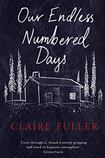
At that time of year when families set off on holidays, spare a thought for Peggy Hillcoat, the eight-year-old protagonist of Claire Fuller's intriguing debut novel Our Endless Numbered Days. Peggy, an observant only child, believes she is leaving her London home with her father James for a short holiday.
Armed with a map, a tent and rucksacks filled with provisions, this is no ordinary trip to the seaside: “In the morning I was woken by three short blasts of the whistle . . . ‘Pack your rucksack, Peggy,’ he said, using his military voice. ‘We’re going on holiday.’ ”
Peggy’s father James is a survivalist, an intense and opaque character who is part of the North London Retreaters. It is 1976 and the group believes an apocalypse is imminent from a Soviet nuclear attack. “Bug-out locations” are a main topic of conversation, with a cabin in the German wilderness suggested by one member, the shifty Oliver Hannington, as an ideal place to survive the end of the world.
Unbeknownst to Peggy, this cabin, "die Hütte", is where James is taking her. His decision is prompted less by the end of the world and more by the end of his marriage to the self-centred Ute Bischoff, a famous German pianist who is away touring when her husband and daughter leave.
A somewhat hammy altercation between James and Oliver precedes the trip, with Peggy unable to understand the nature of the adult fight.
The journey from London to Germany is rushed and confusing. The pair seem to bypass whole countries with an almost mythical ability. The book gets going when they reach their new home, a brilliantly depicted wilderness where James’s survivalist knowledge comes into its own: catching squirrels, insulating cabins, using every bit of the rabbit, “saving the bones for needles, trying to form thread from the guts”.
Our Endless Numbered Days, which recently won the 2015 Desmond Elliot Prize for debut novels, brings the reader back to nature with its lush imagery and post-apocalyptic setting: "Closer to the bank the current dragged lengths of weeds along with it so it seemed that long-haired women swam just under the surface, never coming up for air."
Fuller is a talented writer with a lyrical and cadenced style. From Winchester, she is also an artist and sculptor who began to write at 40 after taking a master’s in creative writing.
There are fairytale connotations throughout the novel – Grimm-like forests, horrible winters, trails of breadcrumbs, Peggy rechristened ‘Punzel’ by her father – that add to the eerie, otherworldly quality of the book, which sees the father-daughter relationship move to a darker place as Peggy grows older.
Dual narratives, set nine years apart, contrast life in the forest with London in 1985, where a traumatised Peggy has recently returned without her father.
This structure could be tighter, with pacing problematic. The aftermath, which is how these types of novels work to create suspense, isn’t properly explored. It is difficult to get a sense of Peggy as a teenager, back in London with secrets that are revealed too hastily at the end and in a way that will be foreseeable for the discerning reader.
The psychology behind the move to the wilderness and the unnatural things that, somewhat inevitably, occur there needs further teasing out.
Why does Peggy, a smart child, accept her father’s stories that the world has ended? Why does James take his anger at his wife to such an extreme conclusion? How is he so detached from reality and what caused him to end up like this?
In terms of plot and setting, there are parallels between Fuller's book and Emma Donoghue's Room, but the latter manages to create suspense in a way that this debut does not, notably by giving more insight into the characters and their development, good and bad.
In Our Endless Numbered Days, the plot is secondary to the writing and the author's ability to recreate life in the wilderness.
Fuller’s eye for unusual details complements the strangeness of her story. Oliver the villain laughs “like a machine gun, jerky and uncontrolled”; a beloved doll is one of the few keepsakes from Peggy’s old life and works well to externalise the girl’s mental disturbance.
In the opening chapter, Peggy studies an old photo of her father before cutting out his face with a scissors and placing it inside her bra.
The book is admirably restrained in its depiction of horror, letting the reader fill in the blanks. " 'This is all there is,' my father shouted, his veins standing out on his bony temples. 'If you don't like it you can leave.' He held the door open and a swirl of snow came in." There is no monster guarding the door of die Hütte, but as with most nightmare scenarios, there is also no clear escape route.









